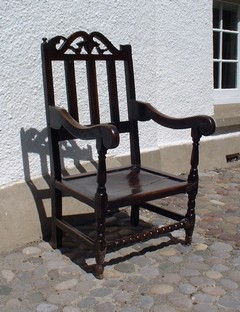METHODISM AT PITTON
(written in 1987 by the members of Pitton Chapel and copied from the booklet which was printed at the time).
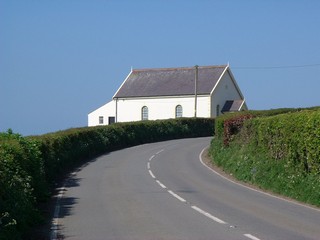 The event being celebrated today, in the presence of the Vice President of the Methodist Conference, is the one hundredth anniversary of the opening of the present chapel building in 1887. It is clear, however, that the history of the Methodist cause in this parish of Rhossili is far older. It extends back into the age of the great itinerant revivalists of the eighteenth century – to the days of Howell Harris, the Welsh Calvinistic Methodist leader and of John Wesley, the father of Wesleyan Methodism. Its roots lie in an even-earlier Puritan tradition of Protestant Dissent first introduced into Gower in the 1650s.
The event being celebrated today, in the presence of the Vice President of the Methodist Conference, is the one hundredth anniversary of the opening of the present chapel building in 1887. It is clear, however, that the history of the Methodist cause in this parish of Rhossili is far older. It extends back into the age of the great itinerant revivalists of the eighteenth century – to the days of Howell Harris, the Welsh Calvinistic Methodist leader and of John Wesley, the father of Wesleyan Methodism. Its roots lie in an even-earlier Puritan tradition of Protestant Dissent first introduced into Gower in the 1650s.
One of the minor local consequences of the Parliamentary victory in the Civil Wars was the displacement in 1650 of the Anglican rector of Rhossili by Daniel Higgs, a popular Independent (or Congregationalist), preacher from Worcestershire. Although he held the living only until 1661 (when he was replaced by his predecessor), Daniel Higgs’ short ministry had a profound influence on the spiritual life of the parish. For the next three centuries, Nonconformity in varying forms remained strongly entrenched at all levels and in most aspects of village life.
From these beginnings at a time of persecution, the first dissenters of Rhossili led a determinedly independent existence. Except for occasional preaching visits from their former pastor, they were without the guidance of a regular minister. Between 1662 and 1666 five of their number John Thomas, William Richard, David Griffiths, Richard Brooke (? Bevan) and David Gamon were fined for non- payment of church rates. Two years later, the same John Thomas, together with John Taylor, William Beynon and Rees Pugh, was again fined for not attending the parish church.
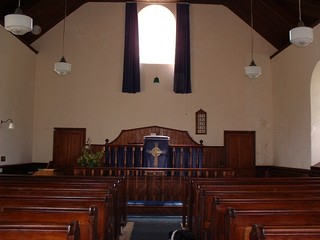 These intermittent persecutions were eased after April 1672 when the house of Richard Bevan in Rhossili was offically licenced as an Independent meeting house. By 1676 the Rhossili Independent congregation numbered 45 (about one third of the parish population) and, with its own recognized meeting place, was the largest group of dissenters in Gower.
These intermittent persecutions were eased after April 1672 when the house of Richard Bevan in Rhossili was offically licenced as an Independent meeting house. By 1676 the Rhossili Independent congregation numbered 45 (about one third of the parish population) and, with its own recognized meeting place, was the largest group of dissenters in Gower.
For the next seventy years, there survives little historical evidence as to the fortunes of this remote congregation. It must still have been sufficiently large in the 1740s to attract the attention of Howell Harris, the great preacher of the Welsh Calvinistic Methodists, who penitrated as far as Rhossili in May 1742. ‘I have been’ he wrote, ‘to the Lands End in Gower’ but stayed only one day. It was probably with such visits in mind that the parish curate reported in 1755 that ‘we have a meeting house but no constant teacher, only some itinerants famous for noise’. When, therefore, the first Methodist preachers came to Gower some ten years later, there was already in Rhossili a strong nonconformist tradition and probably the remnants of an active congregation, but one without ministerial leadership and organization.
John Wesley is known to have visited Gower at least four times between 1762 and 1773. In his 1764 diary, he described the Gower people as ‘the most plain loving people in Wales’, adding in unconscious tribute to their past nonconformist witness ‘It is therefore no wonder that they receive the Word with all readiness of heart’. Although there are no confirmatory entries in his diaries for these years, it can be assumed that during one or more of his visits, Wesley did preach at Pitton—most probably at Great Pitton Farm. . The earliest documentary record of a methodist society in the parish dates from 1797 when it is described as being ‘in Middleton’, but this reference probably post dates the actual foundation of the society by some thirty years.
The connection with Great Pitton was renewed in 1833 when the first purpose-built chapel was erected in Lower Pitton on land leased from Mary Beynon of Great Pitton Farm. This development reflects the growing population and prosperity of the village (based largely on the limestone quarrying trade), and a remarkably high rate of church and chapel attendance. In both the census years of 1831 and 1851, Rhossili was amongst the few parishes in Glamorgan with a church attendance rate of above ten per cent of its population, while the chapel congregation was estimated at an even higher figure. From 1848, the chapel was also used for two hours every week for Sunday School which, within two years, had an average attendance of sixty-five scholars. These were mostly under fifteen and were all reported to be able to read the Scriptures.
After 1870, the village population fell steadily as many moved to Swansea or emigrated overseas. The Pitton membership roll fell from 54 in 1877 to 40 in 1887 and the Gower Circuit membership from 176 to 132 over the same period. It is now difficult, after one hundred years, to fathom the reasons behind the erection of the present building in 1887, clearly a time of decreasing membership. They may perhaps lie in the strong feelings of common identity and strength felt unconsciously by the Pitton Methodists of the 1880s, a time of considerable sectarian bitterness in the village. No longer content with a humble barn-like structure obscurely nestling in Pitton Valley, the congregation (still the largest Methodist society in Gower), decided to put up with much effort and expense, a highly visible building of considerable architectural grace set squarely at the side of the main road into the village. Why else should they have chosen a site so exposed to the ever prevailing winds that it had, until then, been used as a place for winnowing corn; or one which, though, equidistant between the twin hamlets of Middleton and Pitton, was equally inconvenient for both?
For whatever reason, in August 1886, twelve trustees for the society (Thomas Davies, John Tucker, George Beynon and William Powell all of Pitton, Morgan Beynon, William Jones and George Beynon of Middleton, John Rogers and William Thomas of Rhossili and George Beynon of Pitton Cross, all farmers, together with William Richards of Rhossili builder and George Richards of Middleton grocer), took a 999-year lease from the Penrice Estate of a plot of land already staked out in the north-east corner of a field tenanted by William Jones called ‘By-east-the-town’ (locally ‘Bestatown’). On this site they had permission to build a Wesleyan chapel and were obliged to pay an annual rent of 10 shillings. This payment ceased when the chapel freehold was purchased in 1961.
The actual building work was carried through quickly and successfully in less than a year. The stone was quarried locally and auled to the site by the Pitton members with the help of fellow Gower Methodists. No professional architect seems to have been employed and both the design and building fabric were probably the work of two local masons, William Richards of Rhossili and Frank Tucker of Horton. The carpenter, Francis Gibbs of Horton, also made the pulpit and pews. The new chapel, which contained a stable for the preacher’s horse, was valued at £500. It was opened without debt or any grant from central Methodist funds. This was undoubtedly a triumph of ambition, enterprise and devotion for what was still an isolated, peasant community. Three years later, the medieval village church was restored, largely at the expense of Miss Talbot of Penrice Castle.
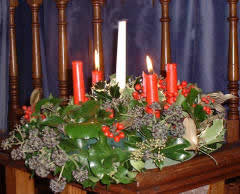 The 1833 chapel building remained in use as a school-room until the early years of the present century and later as a granary. It has now been converted into a private dwelling, appropriately named ‘The Old Chapel’, and is occupied by a descendant and name-sake of the original lessor.
The 1833 chapel building remained in use as a school-room until the early years of the present century and later as a granary. It has now been converted into a private dwelling, appropriately named ‘The Old Chapel’, and is occupied by a descendant and name-sake of the original lessor.
From its opening, the new chapel building attracted considerable attention from outside the village. The idea of building a new chapel at Murton originated at a Sunday School outing to Rhossili in the early 90s, when Pitton was much admired. Twenty years later in evidence to a Royal Commission, Pitton was described as being ‘a little bit superior’, in contrast to other Methodist Chapels in Gower which were dismissed as ‘very simple common buildings . . . built in the same dog kennel fashion’.
Since then and throughout its first century, Pitton Chapel has been cherished by its members with love and care. Over the years, there have been decorations and redecorations, latterly and most colour- fully with the help of the Manpower Services Board. Roof slates are still replaced as regularly as they are dislodged by Atlantic gales. In 1929 oil lamps gave way to acetylene lighting which in turn was replaced by electricity ten years later, much to the annoyance of younger members of the congregation who rather enjoyed its frequent breakdowns. Heat, once generously dispensed by a large black tortoise stove in the centre of the chapel, now rises, sometimes rather slowly, from neat under-seat piping. The congregation alas, appears to be getting older and seems much smaller. The ministers, until recently, are getting younger. The yearly round of social events which once revolved around the chapel is now but a memory, though older members still nostalgically recall its heady pleasures. Beginning with the children’s Christmas Party, with the tree from the Castle and presents for everyone, there followed in unchanging succession the May Tea (and new summer clothes), the Sunday School Outing to Tenby, Barry or sometimes as far as Cheddar Gorge, then the aromatic delights of Harvest Festival, until finally it was Christmas once again and time to go carol singing round the village for the National Children’s Home.
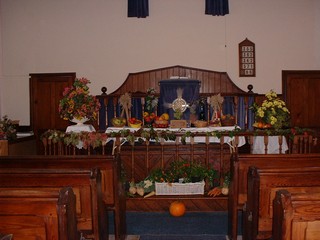 Our harvests continue to be celebrated at Pitton with joy and thankfulness. Carol singing remains ever popular though now more of a village effort shared and enjoyed by Church and Chapel together. These ecumenical activities are now a very pleasing feature of village life, as are our occasional united services. May this be the pattern for the next century of Methodism at Pitton.
Our harvests continue to be celebrated at Pitton with joy and thankfulness. Carol singing remains ever popular though now more of a village effort shared and enjoyed by Church and Chapel together. These ecumenical activities are now a very pleasing feature of village life, as are our occasional united services. May this be the pattern for the next century of Methodism at Pitton.
Pitton Chapel Members 1987
Update to 2012 from Carolyn Jenkins, Chapel Steward
Since 1987 we have lost some of our older members but we are pleased that we have received some new members into the Church, generally people who have moved into the area.
In 2010 it was decided to embark on a refurbishment project as the roof and interior were in need of attention so fund raising started in earnest.
The roof was felt and battened, the slates replaced and the roof space insulated. Inside the old plaster was hacked off revealing very attractive stonework which was then pointed with lime mortar. New heaters replaced the original ones, new pew cushions replaced the old felt ones and additional effective lighting was installed.
Some pews were sold off and more space was created at the front of the Church which enabled the altar rail to be brought out giving more space for serving communion and the pulpit, aisle, front area and vestry was re-carpeted. The existing glass in the window above the pulpit was replaced by magnificent stained glass created by Mary Hayman, a local artist and a member of the Sketty Church. Finally the outside, which had had some repair work to the plastering, and vestry were re-decorated.
The Chapel re-opened in April 2011 and since then there has been a Christening and a Wedding in addition to the fortnightly services, joint Carol Service with St Mary’s Church, Rhossili, Circuit meetings and a very successful concert given by the Phoenix Choir from Swansea.
List of ministers to present day
| 1866 R.E. Bray
1869 Seth Dixon 1870 R.H. Mole 1873 J.G. Cocks 1876 E. Biscombe 1877 J.D. Clark 1879 W.P. Ellis 1882 D.A. Hay 1885 T.F. Brynant 1888 Alfred Kirk 1891 W.T.Pullen 1894 C.A. Booth 1897 Cornelius Wood 1900 Joshua Fielden 1903 A.T. Humphreys 1905 W. Pallister 1907 Arthur Roberts 1908 B.W. MacAdo 1911 C.A. Harris 1914 Jesse Moore 1918 H.B. Turner 1921 F.B. Hankinson 1924 Arnold Crawshaw 1926 R.H. Colwell |
1927 E. Bowen
1930 R.C. Hutchinson 1933 Allan Millar 1935 Cyrus Burge 1938 Harry Arnett 1941 Francis Coles 1944 F.B. Hankinson 1948 H.A. Bishop 1955 R.B. Hems 1957 J.R. Lusty 1959 G.R. O’Neill 1962 K. Collins 1965 R. Lindfoot 1966 R. Marsland 1971 R. Hargraves 1974 G.A. Courtney 1980 Peter Dolling 1985 Harry Goodman 1990 Alwyn Evans 1995 Alf Austin 2008 Muduma Francisco 2009 Howard Long 2010 Andy Walker |

